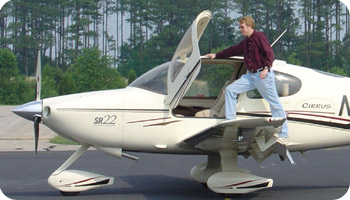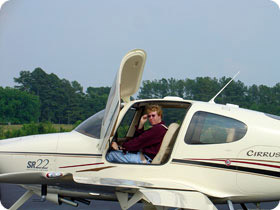|
|
March Fly-Bys
Engine Management on the Fly
By Austin Meyer
Laminar Research
 When I started flying back in the late 80’s, I spent most of
my time in old rented 152s, 172s, and Warriors. Back then, thanks
to the old-school systems and instruments in most planes, engine
management methods were pretty rough - just lean until the engine
starts to run rough and then richen one-and-a-half turns. To this
day I don't even know if that was rich of peak or lean of peak! Gasp!
And what WAS my actual fuel-flow, anyway? I would just look up an
rpm and altitude in the POH and use that number to predict how much
fuel was going out of the tanks (which of course could be different
than my actual burn that day), so I never really knew what the thermal
loads on the engine were, how much fuel I was burning, how much I
had left, or how much I would have when I arrived! Throw in the fact
that I was constantly trying to manually steer from one VOR to another
(which takes about 50% of my concentration right there, leaving me
little time to check on weather down the road) and no wonder I took
every cross-country with some trepidation! Of course the flying was
still fun, in much the same way driving a classic Model-T down your
neighborhood street to the amusement of the neighbors is fun: it
is cool to recall the old days, enjoying the antique machinery and
lifestyles of the past. When I started flying back in the late 80’s, I spent most of
my time in old rented 152s, 172s, and Warriors. Back then, thanks
to the old-school systems and instruments in most planes, engine
management methods were pretty rough - just lean until the engine
starts to run rough and then richen one-and-a-half turns. To this
day I don't even know if that was rich of peak or lean of peak! Gasp!
And what WAS my actual fuel-flow, anyway? I would just look up an
rpm and altitude in the POH and use that number to predict how much
fuel was going out of the tanks (which of course could be different
than my actual burn that day), so I never really knew what the thermal
loads on the engine were, how much fuel I was burning, how much I
had left, or how much I would have when I arrived! Throw in the fact
that I was constantly trying to manually steer from one VOR to another
(which takes about 50% of my concentration right there, leaving me
little time to check on weather down the road) and no wonder I took
every cross-country with some trepidation! Of course the flying was
still fun, in much the same way driving a classic Model-T down your
neighborhood street to the amusement of the neighbors is fun: it
is cool to recall the old days, enjoying the antique machinery and
lifestyles of the past.
Anyway, I flew that way for about 15 years
and built about 600 hours in those old rentals. Two years ago,
I grabbed a Centennial Edition
Cirrus SR-22. Since then, I’ve flown over 300 hours in the
bird and have learned what engine management REALLY is . . . AND
I WANT YOU TO KNOW TOO!!!
With the systems in the Cirrus, I MANAGE
the flight to maximum safety and efficiency rather than constantly
needing to obsess
over heading
and altitude to make it from one VOR to the next. This means realizing
minimum fuel-burn and maximum situational awareness. With the Cirrus,
I just dial in my destination with a bit of twisty-twisty on the
Garmin-430 and while, the Cirrus whisks me to my next destination,
I get to spend my time on other things, like asking: "What
is the weather here?" "What is it where I am going?" "What
is the EGT, CHT and fuel flow now?" "How hard am I running
the engine?" "How close to max power am I?" "How
close to max EFFICIENCY am I?" "How much fuel, in minutes,
will I have in the tanks when I land?" With the tools in the
Cirrus, all of these questions are easily answered. When you MANAGE
the whole of the flight rather than just focusing on the next VOR,
your flying gets a lot safer.
 So, how do you fly a Cirrus efficiently?
Well, in my case I fly as high as possible! You’ll usually
find me at 17,000 feet, sniffing oxygen and running lean of peak.
At that altitude, there is less
traffic, less parasite drag on the plane, and less fuel being drunk
by my engine. With a wide-open throttle, I am only producing 49%
power, but I can easily run lean-of-peak at Best Economy while
making 165 KTAS, burning 10.5 gallons per hour, and seeing nearly
18 miles
per gallon. Compare that to the 175 KTAS, 18 gallons per hour,
and 11 miles per gallon I would get at a lower altitude and Best
Power
mixture setting: The choice is a no-brainer. I mean, imagine! Only
10 knots less speed, but fuel savings of about 40%! WOW! Of course,
up high we also get a smoother ride, greater gliding distance and
better radio reception. So, how do you fly a Cirrus efficiently?
Well, in my case I fly as high as possible! You’ll usually
find me at 17,000 feet, sniffing oxygen and running lean of peak.
At that altitude, there is less
traffic, less parasite drag on the plane, and less fuel being drunk
by my engine. With a wide-open throttle, I am only producing 49%
power, but I can easily run lean-of-peak at Best Economy while
making 165 KTAS, burning 10.5 gallons per hour, and seeing nearly
18 miles
per gallon. Compare that to the 175 KTAS, 18 gallons per hour,
and 11 miles per gallon I would get at a lower altitude and Best
Power
mixture setting: The choice is a no-brainer. I mean, imagine! Only
10 knots less speed, but fuel savings of about 40%! WOW! Of course,
up high we also get a smoother ride, greater gliding distance and
better radio reception.
Some people think that running lean of
peak might damage the engine and cringe when I say I run at Best
Economy. NO WAY! While you’d
better NOT lean the engine to peak EGT at 100% power and leave
it there (because of course that WOULD cause problems!), having
an EGT
on each cylinder means that we can ALWAYS go back to 50 degrees
LEAN of peak with 100% confidence that we are NOT running right
at that
dangerous peak. Instead, we’re 100% sure that we ARE being
safe with the engine while realizing huge fuel-savings as well.
The old days of being afraid to lean the mixture to LOP for fear
of damaging
the engine are OVER! We can now lean safely, every time, and burn
less fuel to get where we are going.
Now, using these techniques,
I can easily make a non-stop flight from South Carolina to Texas,
Kansas, or Massachusetts without
touching my IFR fuel reserves, even with a moderate headwind!
If I had flown
lower, my fuel consumption would have increased by nearly 75%,
while my speed would have gone up by only 6%! Again, the choice
is obvious.
Now, let's say I did NOT have the engine-monitoring. Let's say
I did NOT have the fuel-remaining-on-arrival prediction from
the EMax.
Let's say I did NOT have the autopilot. Let's say I did NOT have
the dual GPS. What would it be like flying then? I would be burning
more fuel, afraid to run LOP for fear of being too close to peak
EGT, focusing on the next VOR instead of the BIG PICTURE, and
watching my altimeter and HSI rather than my fuel and weather
situation.
That's less safe, less convenient, less capable. With my Cirrus,
I know
and can reach my steed's capabilities and limits. That's the
difference between traveling and antiquing.
Austin Meyer is the founder and owner of Laminar Research, the
development group responsible for the X-Plane flight simulator.
To download a
free demo of X-plane, go to www.x-plane.com.
Austin
is also offering Pilot’s World readers a free altitude
and fuel optimizer, downloadable at www.x-plane.com.
Back to top |
|


